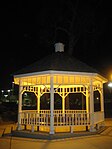Irvine Valley College
Irvine Valley College (also known as IVC or Irvine Valley) is a public community college in Irvine, California. It is part of the California Community Colleges System. The college inherited its name from the Irvine family and the Irvine Company that were key in the development of the city of Irvine. Opened in 1979 as Saddleback College North Campus, Irvine Valley College received its current name and independent status in July 1985. In July 1988, the college received its first accreditation as a separate institution by the Accrediting Commission for Community and Junior Colleges (then the Western Association of Schools and Colleges). The school provides associate of art and science degrees, certificates of achievement, and lower-division transferable courses to other colleges and universities. It enrolls nearly 13,000 students.
Excerpt from the Wikipedia article Irvine Valley College (License: CC BY-SA 3.0, Authors).Irvine Valley College
Barranca Parkway, Irvine Oak Creek
Geographical coordinates (GPS) Address External links Nearby Places Show on map
Geographical coordinates (GPS)
| Latitude | Longitude |
|---|---|
| N 33.676666666667 ° | E -117.77777777778 ° |
Address
Irvine Valley College
Barranca Parkway
92618 Irvine, Oak Creek
California, United States
Open on Google Maps








